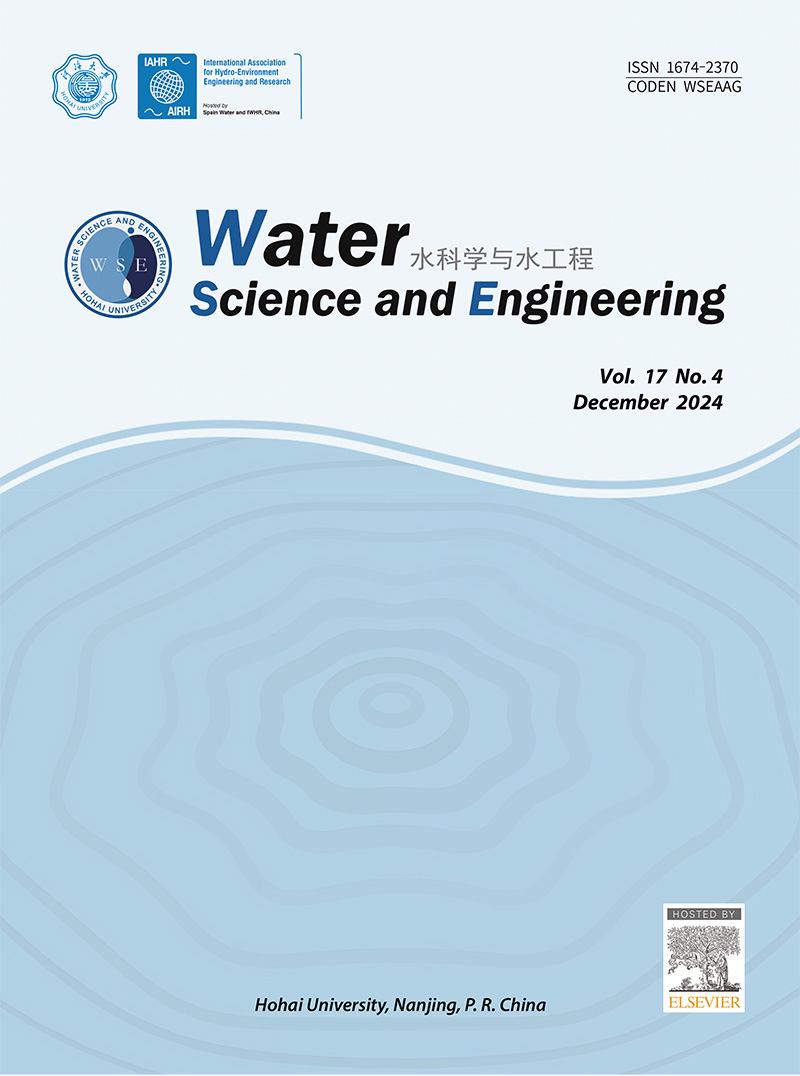大豆渣磁性生物炭活化过氧化氢降解水中四环素的研究
IF 4.3
Q1 WATER RESOURCES
引用次数: 0
摘要
四环素(TCs)是世界上第二大常用抗生素,用于医疗和畜牧业。虽然对各种传染病有效,但TC残留物持续存在于环境中,并导致耐抗生素病原体的出现,对人类健康构成重大风险。本研究采用非均相Fenton法,以大豆渣衍生的磁性生物炭(Fe-SoyB)为催化剂降解TC。利用x射线衍射(XRD)、扫描电镜(SEM)、傅里叶变换红外光谱(FTIR)和超导量子干涉器件(SQUID)技术对Fe-SoyB样品进行了表征。考察了pH、H2O2浓度、催化剂用量、TC初始浓度等关键参数对TC降解的影响。结果表明,随着初始TC浓度的增加,TC的去除率降低,而随着H2O2浓度和催化剂用量的增加,TC的去除率提高。确定了类fenton工艺的最佳条件:pH = 3, H2O2浓度为245 mmol/L,初始TC浓度为800 mg/L,催化剂用量为0.75 g/L, 150 min后的TC去除率为90.0%。此外,Fe-SoyB体系在不同水基质中的TC去除率差异显著,去离子水为87.1%,自来水为78.5%,河水为72.5%。该催化剂表现出明显的稳定性,经过3次循环使用,仍能保持79.7%的TC去除率。总的来说,Fe-SoyB显示出作为消除水溶液中有机污染物的具有成本效益的催化剂的前景。本文章由计算机程序翻译,如有差异,请以英文原文为准。
Degradation of tetracycline in water using hydrogen peroxide activated by soybean residue-derived magnetic biochar
Tetracyclines (TCs) are the second most commonly used antibiotics worldwide, utilized in medical treatments and animal husbandry. Although effective against various infectious diseases, TC residues persist in the environment and contribute to the emergence of antibiotic-resistant pathogens, posing significant risks to human health. This study employed the heterogeneous Fenton process to degrade TC using soybean residue-derived magnetic biochar (Fe-SoyB) as the catalyst. The Fe-SoyB sample was characterized using X-ray diffraction (XRD), scanning electron microscopy (SEM), Fourier-transform infrared spectroscopy (FTIR), and superconducting quantum interference device (SQUID) techniques. The effects of key parameters, including pH, H2O2 concentration, catalyst dosage, and initial TC concentration, on TC degradation were investigated. The results indicated that the TC removal efficiency decreased with increasing initial TC concentration, while it was improved with higher H2O2 concentrations and greater catalyst dosages. The optimal conditions for the Fenton-like process were determined: a pH of 3, a H2O2 concentration of 245 mmol/L, an initial TC concentration of 800 mg/L, and a catalyst dosage of 0.75 g/L, achieving a removal efficiency of 90.0% after 150 min. Additionally, the TC removal efficiency of the Fe-SoyB system varied significantly across different water matrices, with 87.1% for deionized water, 78.5% for tap water, and 72.5% for river water. The catalyst demonstrated notable stability, maintaining a TC removal efficiency of 79.7% after three cycles of use. Overall, Fe-SoyB shows promise as a cost-effective catalyst for the elimination of organic pollutants in aqueous solutions.
求助全文
通过发布文献求助,成功后即可免费获取论文全文。
去求助
来源期刊

Water science and engineering
WATER RESOURCES-
CiteScore
6.60
自引率
5.00%
发文量
573
审稿时长
50 weeks
期刊介绍:
Water Science and Engineering journal is an international, peer-reviewed research publication covering new concepts, theories, methods, and techniques related to water issues. The journal aims to publish research that helps advance the theoretical and practical understanding of water resources, aquatic environment, aquatic ecology, and water engineering, with emphases placed on the innovation and applicability of science and technology in large-scale hydropower project construction, large river and lake regulation, inter-basin water transfer, hydroelectric energy development, ecological restoration, the development of new materials, and sustainable utilization of water resources.
 求助内容:
求助内容: 应助结果提醒方式:
应助结果提醒方式:


